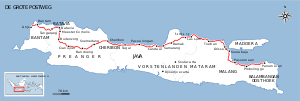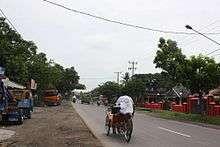Great Post Road
The Great Post Road (Indonesian: Jalan Raya Pos, Dutch: De Grote Postweg) is one of the main roads of Java Island, that spans from its west coast at Anyer, to Panarukan at the east.

- This article is an itinerary.
Understand
The Great Post Road was built by the administration of the Dutch East Indies in the early 19th century. Governor-general Herman Willem Daendels decided on building the road mainly for defense purposes, to be able to quickly move troops in case of an attack by the British that were in present-day Malaysia. According to most estimates, thousands of forced labourers died while building the road, which was completed within one year, in 1808. The road did not stop the British from invading, and Java was under British rule from 1811 to 1814. Nevertheless, the Great Post Road has remained important for the communication and trade throughout the 19th and 20th centuries. Almost all of the major towns and cities of Java were along the route, such as Batavia (present-day Jakarta), Semarang, and Surabaya. Many places along the road in addition developed to become important because they were a resting place along the road. Ane example is the city of Bandung.
The Great Post Road is about 1,000 km long. There are barely any noticeable signs that the road you are traveling on is indeed the Great Post Road. In some places, the Great Post Road is still the major road, and often it is the same as Indonesia's National Road 1 (also called North Coast Route, Jalan Pantura). However, in other places new roads have been built and the Great Post Road is now not more than a small village road. In many places also tolled motorways have been constructed, to take over the function of the Great Post Road.
Nevertheless, following the route of the Great Post Road will bring you to many places that have been important in the history of Java and Indonesia.
Prepare

Have or rent a car or a motorcycle as it is the most convenient way to traverse this road. If you prefer public transportation, there are a number of buses that goes through this road between major cities. The journey should take up to 4 days, assuming a good night rest after a journey of 12 hours each day. If you wish to explore the major cities, expect about a week or up to 10 days. Rest options and fuel stations are aplenty as these routes are also used by buses, trucks, and the annual temporary migration at the end of Ramadan.
By and large, the road can be traveled throughout the year. It is not advisable to travel during the end of Ramadan holiday period. Most parts of the roads are clogged by travelers homebound to their family's houses at the beginning, and back to the cities at the end. Other than that, your journey might be temporarily halted by traffic at the major cities, especially in Jakarta, and during the weekends & public holidays at Puncak, Bandung, and other resort towns. At rainy season, visibility can drop dramatically during storms and may cause some portions impassable due to flooding and landslide at the foothills.
Get in
As the Great Post Road traverses the entire island, it is easy to get to the road. The only major city of the island that is not on the route is Yogyakarta. To get to the Great Post Road from Yogyakarta, drive northwards and follow the signs to Semarang.
Near the route of the Great Post Road, there are airports in Jakarta, Bandung, Semarang, and Surabaya.
Drive
Banten

The official starting point is at the lighthouse of 🌍 Anyer in Banten province in the far west of the island. A monument (Tugu Nol Kilometer or Zero Kilometre Monument) is next to the lighthouse. In the colonial time, Anyer was an important sea port, but nowadays the port of Merak about 25 km to the north is much more important. From Anyer, the road runs along the Sunda Strait coast to the city of 🌍 Cilegon. The route then continues to the north coast, at the Java Sea, to the town of 🌍 Banten. Banten used to be the centre of the Banten Sultanate, but nowadays it is no more than a small village with many historic buildings. Back inland, the road crosses the city of 🌍 Serang and from there goes in eastern direction to the capital. Here, the Great Post Road is not the main road anymore, as there is now also a tolled motorway. Via 🌍 Balaraja, the western suburbs of Greater Jakarta are reached, including the major city of 🌍 Tangerang.
Jakarta
When the Great Post Road was constructed, the area that is now Jakarta consisted of a large number of towns and villages, that have since all grown together. The route crossed Batavia (the 🌍 Old City of Jakarta in North and West Jakarta), Ancol on the north coast, the Batavia suburb of Weltevreden (now around the 🌍 National Monument in Central Jakarta), and the town of Meester Cornelis (now 🌍 Jatinegara in East Jakarta).
West Java

While most of the Great Post Road runs along or near the north coast of Java, the section in the province of West Java is an exception. Between Jakarta and Cirebon, the route makes a long detour through the mountains. South of Jakarta, the route passes the city of 🌍 Depok and then continues to 🌍 Bogor (known as Buitenzorg in the colonial time). That city was the summer capital of the Dutch colonial government, and the summer residence of the governor-general is nowadays still one of the presidential palances. After Bogor, the road goes to the east again, to traverse the 🌍 Puncak pass, with its many tea plantations. On the other side of the mountain, the route continues to the city of 🌍 Cianjur, and then to 🌍 Cimahi and Bandung.
The city of 🌍 Bandung developed around the place where the Great Post Road crossed the Cikapundung river. During the colonial time the city was called the Paris of Java because of its architecture. Some of the hotels that were built along the Grote Postweg (in Bandung now called Jalan Asia-Afrika) are now among the most famous hotels of the country.
From Bandung, the route continuous to 🌍 Sumedang at the foot of the Mount Tampomas volcano, and then via Kadipaten near Majalengka back to the Java Sea coast at 🌍 Cirebon, the 'city of shrimps'. From there, the route follows the north coast again in eastern direction, towards Central Java.
Central Java

In Central Java, the route follows the north coast, except for the peninsula of Jepara. From the provincial border, the route goes to the city of 🌍 Tegal. The region of Tegal, and the next city on the route 🌍 Pekalongan, were in the colonial time known for the production of sugar. Then, the following major city on the route is the capital city of Central Java, 🌍 Semarang. Bypassing the peninsula of Jepara and Mount Muria, the route traverses the town 🌍 Kudus, a centre of Indonesian cigarette production, and 🌍 Pati. Back at the Java Sea coast, the Great Post Road passes the town of 🌍 Rembang before crossing into East Java.
East Java
In East Java, the entire route of the Great Post Road is near the coast. The first larger town, about 45 km after the provincial border crossing, is 🌍 Tuban. From there, the original route of the Great Post Road along the coast is no longer a major road, as the main National Road 1 goes directly in southeastern direction to Gresik and Surabaya. The Great Post Road follows the coastal route via the town of 🌍 Sidayu, before turning southwards to 🌍 Gresik, known for the largest cement factory of the country.Nowadays, Gresik is a suburb of the next city on the route, 🌍 Surabaya. Surabaya is the capital city of East Java, and the second-largest city of Indonesia.
From Surabaya, the road goes further south, to 🌍 Pasuruan. The region of Pasuruan was another important region of sugar cane production. From here, the route goes eastwards again, to the port city of 🌍 Probolinggo and then to the eastern terminus at 🌍 Panarukan. Panarukan is not at the far eastern end of the island, and therefore the route was later extended to Banyuwangi and the port of Ketapang, where ferries depart for Bali.
Eat
Eating options are ubiquitous at major cities and holiday resorts, although you might need to get off the road first before rejoining back in. Outside these areas though, good luck finding international or even Chinese cuisine! The norm is usually Javanese cuisine at Central and East Java, Sundanese at West Java and Banten. Rice is the staple while platters could vary but at least a piece of poultry or beef, and vegetables, should satisfy. Better yet are if you find Padang restaurants, known by the prominent high roof; they have a greater number of menus and you can look at them before choosing what you want. Do eat at better establishments as that means better hygiene! For the best bet for savory food & clean shacks, look if there is at least one bus parking there, it is usually the restaurant specific bus companies routinely stop by for a rest.
Go next
- Near the western terminus of the Great Post Road, the port of Merak has ferries to the island of Sumatra.
- The ferry port of Ketapang (near Banyuwangi) is about 100 km from the eastern terminus. There you can hop on a ferry to Bali Island.
- From Surabaya, you can take the Suramadu Bridge to Madura
- You can travel on the south route to Yogyakarta, a great method to backtrack and enjoy a different, mountainous scenery.